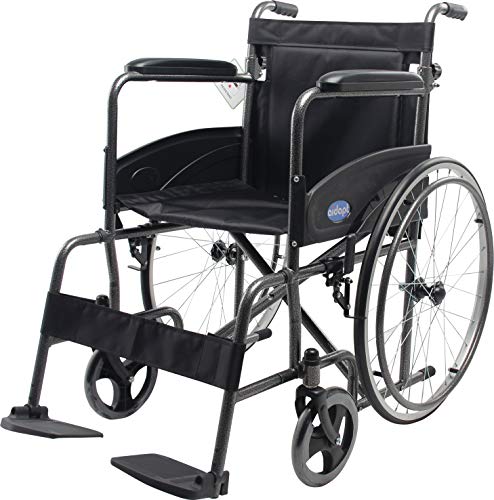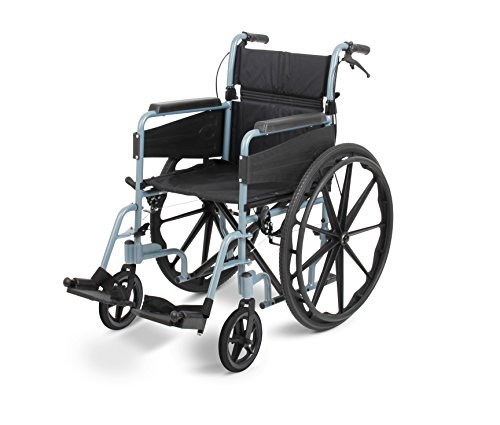Five Killer Quora Answers To How To Self Propel A Wheelchair
페이지 정보
작성자 Clayton Blancha… 작성일24-11-22 13:22 조회6회 댓글0건관련링크
본문
 how to self Propel a Wheelchair to Self Propeller a Wheelchair
how to self Propel a Wheelchair to Self Propeller a WheelchairLearning to self-propulse a wheelchair opens up a whole new world of independence. It requires practice and the correct body posture to be able to do this.
A proper body position requires a precise grip and pushing technique. This article will concentrate on these skills and other aspects of wheelchair propelling.
Hand Positioning
Properly pushing a wheelchair with the hands is an important element of self propelled wheelchair with attendant brakes propelling. Begin with accuracy and then increase speed. Squatting while pushing can improve stability and comfort for users particularly those with upper body restrictions. Hands should be positioned to match the speed of the wheel. Push with both hands, without wrapping the thumbs around the hand-rims. This is a common omission, as it reduces effectiveness and increases the amount of force required for each stroke.
The path for recovery of the hands should be performed in a comfortable pendular pattern below the hand-rims at the end of each propelling cycle to avoid contact with the rear wheels (a "semi-circular" recovery pattern). This minimizes the strain on the shoulders, while keeping the duration of each stroke as well as the number of cycles to an absolute minimum.
For surfaces that are more difficult to maneuver, it is sometimes advised that the user of a wheelchair use long strokes with a full recovery (like the hand position on the clock). This can help reduce shoulder injuries caused by repetitive motion, but it may also increase the burden on the shoulders.
Using the same posture for both braking and propelling can also help minimize shoulder injuries. If the person using the wheelchair is able to keep a steady rhythm during both movements, it will be easier to manage the forces that are applied and to adjust for differences in the terrain.
On surfaces that are muddy or soft it is common to lean forward a bit while driving to stop the front wheels from sinking into ground and tipping backwards. It is worth trying different levels of trunk lean to determine the right balance between too little and too much lean. Regular practice will increase your confidence and proficiency. Wheelchair propulsion is a transformative skill for people with mobility problems. With the right approach and the right equipment as well as some education anyone can learn how to operate their manual wheelchair effortlessly! This entry was filed under News and included in how to wheelchair, wheelchair.
Foot Positioning
It is essential to ensure that the patient's feet are correctly positioned to ensure stability. It's not always the best choice if the wheelchair has feet that are too far apart, as this makes it very difficult to self propel. However, there are times when it is necessary to navigate difficult terrain. For example, if the client is descending a very steep ramp or even across some of our fantastic National Parks or beaches, then the wheelchair must have wheels that can move up and over them in a manner that allows the user to move forward. The front wheels must be positioned as illustrated below.
The client can push the wheels together by grasping the rims. This requires an enormous amount of upper body strength and is very slow, but it is possible and it allows clients who would otherwise not be able down or up hills to accomplish this.
Wheelies are also important to allow the user to get over obstacles like curbs or other people. In this situation, the client will place their left foot on top of their right, to allow them to raise themselves up and over the obstruction. The client will then move their right leg upwards and over the obstacle whilst pushing with their left hand. This is called the crabwalk. It is a very effective way to move a wheelchair across some of our most difficult terrain.
Self-propelled wheelchairs, or manual chairs as they're sometimes called, are an excellent solution for many injured and disabled people who want to be able to walk without relying on someone else for assistance. They are lightweight, compact and foldable, so they take up less space than other mobility aids. They can be converted into powerchairs by using accessories like the E-Motion. This gives the user the freedom of using their chair with the added benefit of electric assistance when required.
Braking
Self-propulsion a wheelchair is a crucial ability for those who have mobility issues. They can navigate many terrains and situations on their own. It also helps to build strength in their shoulders and upper arms.
To propel a wheelchair self propelled forward, the user should apply pressure to the rim of their hand while pulling up on the opposite side. The push-pull motion generates momentum that propels the wheelchair in the direction desired by the user. The speed at which the wheelchair is propelled can be adjusted by applying pressure in a different amount or quantity to the rims or by using hand brakes if they are fitted with them.
The ideal cycle for pushing should last at least 3 hours. This will reduce the time that the shoulder is loaded, reducing the chance of injury due to repetitive strain. The speed at which the wheelchair is propelled will also be affected by the size and width of the rear wheels. Larger wheels require more force to move, while smaller wheels are easier to maneuver. Wheelchairs can also be designed with camber, which increases the ease of pushing by aligning the rear wheels with the biomechanics of the shoulders and maximizing the lateral stability.
Wheelchair users looking to improve their propulsion skills should practice in a secure location, like a parking area or an empty hall. The goal is to develop long, slow strokes, allowing the wheelchair to glide between strokes.
It is also essential for the user to practice moving while moving, like weaving around objects or taking turns. A good way to do this is by weaving through cones, and then gradually transitioning into straight-line movement. The more you practice, the easier this will be.
Self-propelled wheelchairs are a great option to help people keep active and doing things they enjoy. They can offer autonomy and are a great tool for socializing, going to the movie or even travel. If you can learn to use a wheelchair correctly you will be able to continue or restore your independence and get to where you want to be.
Stability
Self-propelling wheelchairs permit wheelchair users to be self-sufficient and travel wherever they want without having to depend on others. However, it requires an adequate amount of upper body strength to push the wheel along flat surfaces and even up small hills. This is the reason why many wheelchair users choose to use an attendant controlled (also known as an attendant propelled) chair like the Action3 NG or ErgoLite 2 and are driven by an attendant.
It is important to learn how to hold the rims of your hands on a manual wheelchair correctly to ensure maximum comfort and functionality. We frequently find that people who use this kind of chair have their hand rims too far forward, which means they are forced to reach further backwards using their arms. This is not a good biomechanical strategy and could lead to strain on the shoulders.
The ideal hand-propulsion pattern is a semicircular one in which the user alternates between the push phase of the wheelchair and the recovery phase. The push phase requires the client to push down on the casters which is done with a lot of small strokes. This push pattern also helps to strengthen the shoulder retractor muscles and maintain an active range of motion.
When the recovery phase starts the client will move their hands back along the wheel's rims until contact is made again with the casters. This allows for longer strokes and also reduces friction during the recovery phase. Some wheelchair users will slide their hands across the rims in a smooth circular motion during this phase, but this isn't as efficient and can cause wear on the rims.
Another important aspect of stability is the position of the rear wheel to allow self-propulsion. If the wheel is placed too far in the rear, the user could tip their wheelchair easily. It can be difficult to maneuver around obstacles and is not recommended for injuries to the shoulder. We must assess the strength of the client, their range of motion, muscle tone and orthopedic status during the seating assessment in order to determine the best self propelled wheelchair uk wheel placement for them.

댓글목록
등록된 댓글이 없습니다.

